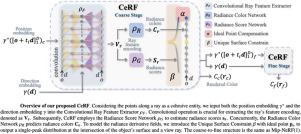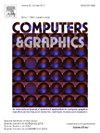CeRF:用于新视图合成的卷积神经辐射导数场
IF 2.8
4区 计算机科学
Q2 COMPUTER SCIENCE, SOFTWARE ENGINEERING
引用次数: 0
摘要
最近,神经辐射场(NeRF)因其能够生成高保真的新视图合成图像而受到广泛欢迎。然而,意想不到的“漂浮幽灵”人工制品通常出现在有限的训练视图和复杂的光学现象。这一问题源于辐射场固有的模糊性,根植于基本的体渲染方程和多层感知器的无限制学习范式。在本文中,我们介绍了卷积神经辐射场(CeRF),这是一种新的方法来模拟沿光线的辐射导数,并通过全神经渲染管道解决歧义。为此,提出了一种包含改进softmax函数和理想点的单曲面选择机制来实现我们的辐射导数场。此外,采用一维卷积操作的结构化神经网络架构,通过提取潜在射线表示进一步提高性能。与现有的最先进的方法相比,大量的实验证明了我们提出的模型的有希望的结果。本文章由计算机程序翻译,如有差异,请以英文原文为准。

CeRF: Convolutional neural radiance derivative fields for new view synthesis
Recently, Neural Radiance Fields (NeRF) has seen a surge in popularity, driven by its ability to generate high-fidelity novel view synthesized images. However, unexpected “floating ghost” artifacts usually emerge with limited training views and intricate optical phenomena. This issue stems from the inherent ambiguities in radiance fields, rooted in the fundamental volume rendering equation and the unrestricted learning paradigms in multi-layer perceptrons. In this paper, we introduce Convolutional Neural Radiance Fields (CeRF), a novel approach to model the derivatives of radiance along rays and solve the ambiguities through a fully neural rendering pipeline. To this end, a single-surface selection mechanism involving both a modified softmax function and an ideal point is proposed to implement our radiance derivative fields. Furthermore, a structured neural network architecture with 1D convolutional operations is employed to further boost the performance by extracting latent ray representations. Extensive experiments demonstrate the promising results of our proposed model compared with existing state-of-the-art approaches.
求助全文
通过发布文献求助,成功后即可免费获取论文全文。
去求助
来源期刊

Computers & Graphics-Uk
工程技术-计算机:软件工程
CiteScore
5.30
自引率
12.00%
发文量
173
审稿时长
38 days
期刊介绍:
Computers & Graphics is dedicated to disseminate information on research and applications of computer graphics (CG) techniques. The journal encourages articles on:
1. Research and applications of interactive computer graphics. We are particularly interested in novel interaction techniques and applications of CG to problem domains.
2. State-of-the-art papers on late-breaking, cutting-edge research on CG.
3. Information on innovative uses of graphics principles and technologies.
4. Tutorial papers on both teaching CG principles and innovative uses of CG in education.
 求助内容:
求助内容: 应助结果提醒方式:
应助结果提醒方式:


